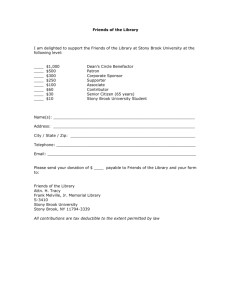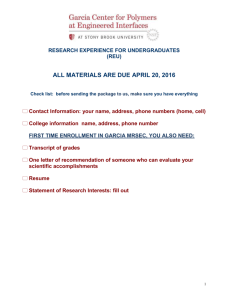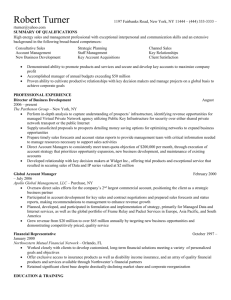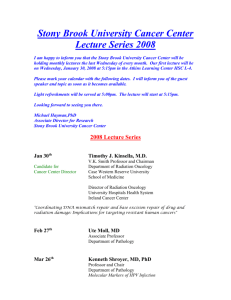fac_hires_4-21 - Stony Brook University
advertisement
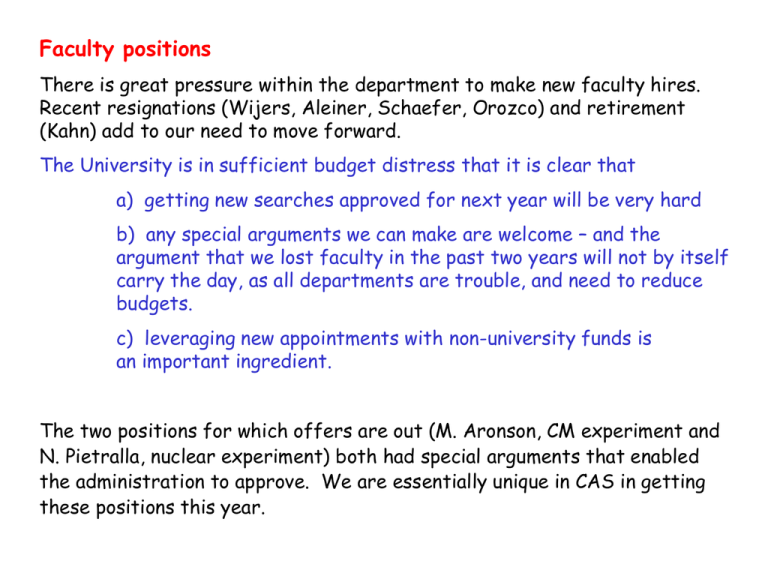
Faculty positions There is great pressure within the department to make new faculty hires. Recent resignations (Wijers, Aleiner, Schaefer, Orozco) and retirement (Kahn) add to our need to move forward. The University is in sufficient budget distress that it is clear that a) getting new searches approved for next year will be very hard b) any special arguments we can make are welcome – and the argument that we lost faculty in the past two years will not by itself carry the day, as all departments are trouble, and need to reduce budgets. c) leveraging new appointments with non-university funds is an important ingredient. The two positions for which offers are out (M. Aronson, CM experiment and N. Pietralla, nuclear experiment) both had special arguments that enabled the administration to approve. We are essentially unique in CAS in getting these positions this year. What I seek in this meeting: I expect that circumstances in the university will change rapidly – generally the prospect for new hires next year is dim. The advice given to CAS is 14% cut from June 2002 over the academic years 2002-4. However, we don’t have a budget from Albany/SUNY Central yet and thus the reaction of the local campus is not yet firm. This year, the advice to the campus has worsened over time but we have seen some minor openings that if we know what we want to do, could be exploited. I would like to have the advice from the department on what our most urgent needs are – not in the sense of a formal report as in the LRP, but more individually. The idea is that I would like to have the sense of the department so as to be able to move rapidly as conditions evolve. I assume that the advice will often be prefaced by ‘the most pressing need is to hire in my own area’ . That is fine, but what I really need is a more global look at the department’s needs, and I will especially value your outlook on the needs in other areas than your own. Advice can come publicly in this meeting or privately later, after more thought and consultation with your colleagues. (I apologize in advance for this meeting not including the full faculty! ) Positions to consider: 1. Astrophysics † 2. Atomic Molecular Optical Physics † 3. Biological physics * 4. Condensed Matter Theory † 5. Instrumental astronomy * 6. Nanofabrication/ devices 7. Nuclear theory † 8. Spin nuclear/particle physics * Positions in nuclear experiment and condensed matter experiment were advocated in the LRP, and offers are now out † == Resignations * == From Long Range Plan report spring 2002 Order is alphabetical ! No sense of priority intended. 2001-2 LRP Committee recommendations: (no priority given): Applying Physics to Biology Condensed matter experimental physics of materials [offer out] Spin Physics from RHIC [search made, no offer] New astronomical research (instrumentation) Low energy nuclear physics [offer out] Also mentioned as desireable: nuclear theory, nuclear astrophysics, high energy physics, condensed matter nanoelectronics, accelerator physics, high intensity laser physics 1999 LRP Committee recommendations: (in priority order) atomic, molecular and optical physics [T. Weinacht hired] high energy physics/neutrinos [C. McGrew hired] astronomy instrumentation physics of biology experimental mesoscopic physics There are many factors that would influence our choice of new hires: How many hires can we make? On what timescale? What does the startup cost? Is there leveraging from outside funds? (BNL, grant, … ) Special resources here to retain a new hire Will new hire encourage a current faculty member to stay? What level should the appointment be? Curriculum pressure Graduate student demand Grant income generated Preserving existing strengths of department Possibilities for new initiatives for research How we proceed will depend on some mix of these factors, and on the external circumstances. The importance of the factors will probably be time-dependent, so getting LRP-type advice with a static outlook is probably not appropriate. Some statistics: RF approximate expenditures by group (taken from AY 2001-2) Group # in group Tot RF ( K$) IDC (K$) K$/faculty Astronomy 9 1103 284 123 CM Theory 3 951 233 317 CM Expt 5 460 82 92 Atmospheric 1 135 35 135 AMO 4 749 144 187 CM devices 3 2850 795 950 Nuc theory 6 1064 345 177 Nuc expt 3 824 156 275 Heavy Ion 3 714 108 238 X ray 2 569 141 285 HE expt 8 2465 397 308 Some statistics: Ph.D. research grad students by group Group # in group #students stud/fac. Astr. Observing 7 5 0.7 Astr. Theory 1.5 3 2 CM Theory 3 4 1.3 CM Expt 5 5 1 AMO 4 15 3.8 CM devices 3 13 4.3 Nuc theory 5.5 8 1.5 Nuc expt 3 5 1.7 Heavy Ion 3 7 2.3 X ray 2 7 3.5 HE expt 8 13 1.6 ITP 10 14 1.4 Some statistics: Grad students by group outside Department Group #students Accelerator(Peggs/BenZvi) 4 AMO (DiMauro) 5 Biophysics(Dilmanian, Reinstein et al.) 8 Chemistry(Stell) 1 CM Theory (Davenport, Essler) 3 The case for hires in the several areas: (my own take … amendments welcome!) AMO Faculty is down to 2.5 + 1 research with departure of L. Orozco and P. Koch to Associate Dean. a) Course pressure: we have several courses that should be taught by AMO faculty: Lasers, Graduate 566 and 567, Optics Rotation, Sr. Lab, Grad Seminar. Current faculty don’t quite go around. b) AMO is a very active field of physics research c) High demand of students (20 current students in AMO PhD research) d) Desire to retain national position after Orozco departure, send signal that Stony Brook remains in the business e) Cost of start-ups is large Astronomy One could argue that two hires are desired – refill the Wijers position, and the hire recommended by the Long Range Plan. The priorities within the Astronomy Group are still being discussed. a) Course pressure: to maintain the AST undergrad major, the set of popular DEC courses, the graduate offerings, and Sr. Lab, we are often short astronomy faculty, particularly when one or more is on leave. b) LAMA initiative: LAMA has made progress in the past year, with a funded phase I, collaboration with Columbia and American Museum of Natural History, and renewed efforts for major donations, plan for building LAMA at Apache Point NM (SDSS) site. Progress raises pressure for instrumental astronomy hire. c) SMARTS consortium telescopes, success in getting Keck, Spanish radio telescope, Hubble time gives improved Stony Brook telescope time. d) Discoveries in astronomy and cosmology are high profile in science and the public. e) Expect the start up cost for an astronomy hire to be rather small, but for the instrumentation position there will be significant needs. f) Student pressure is not high in observational astronomy Biological Physics: Stony Brook has had a very high profile in the area of X-ray optics and its applications for some time. Two long range planning committees have advocated modest expansion here. Last LRP report identified areas: protein structure using electron/X-ray microscopy at BNL/SB; meaning of genome sequences; computational neuroscience. a) Good funding record b) High student pressure c) Small but highly visible group d) Biological physics is clearly a growth field in physics nationally and will be well supported. e) Environmental applications are important socially f) Cost of start up is probably moderately high This position is special as it probably represents a new direction for the department, rather than building within an existing group --- but there will be affinities to the current X-ray group, or perhaps aspects of condensed matter. Condensed Matter Theory: We lost Igor Aleiner. Previous losses (Kivelson, Chakravarty, Hwa, Jain) have been difficult for the department. CM theory has generally appeared on LRP reports when the size of the faculty dipped to the current three . A major and very diverse area of physics that is at the core of most university departments. New subfields of CM appear regularly and need theoretical development. a) Funding is moderate b) Our graduate students have not flocked to CM theory; do we understand this? (4 supported by SB faculty; 3 to outside theorists. Though some students working on nanodevices, microelectronics are effectively doing theory.) d) Cost of start up is relatively small Microelectronics, Nanofabrication: This area was not on the prime list in the past LRP, but is advocated because of special expertise now in place at Stony Brook upon which we could capitalize. (Nanofabrication labs of Jim Lukens) a) Stony Brook effort is well recognized nationally b) General area of nanotechnology is growing, with new opportunities c) Funding possibilities are excellent; our largest area of support d) Student pressure is high e) We have invested in considerable infrastructure in nanofabrication in past; there is an opportunity to exploit this. f) Cost of start up will be reasonably large, though we may hope that existing infrastructure can partially offset. Nuclear Theory: Stony Brook has a long history of nationally recognized strength in nuclear theory. The group has influenced several major aspects of nuclear physics – heavy ions, supernovae, nonperturbative QCD, random matrix theory … Resignation of Thomas Schaefer, loss of state funded research appointment Group is relatively large – five academic faculty and one research professor. There is an active and productive interplay within the group, and with nuclear/RHI experiment. a) Expect BNL RIKEN joint appointment for duration of assistant professor appointment; thus near term cost is small. b) Research funding has been strong c) Start up costs small d) Student pressure is moderate RHIC Spin physics: RHIC is now accelerating polarized protons in addition to heavy ions. The two programs are rather distinct, but both use the PHENIX detector. The polarized program aims to understand what carries the nucleon spin – the gluon, or quark orbital angular momentum effects. We expect RHIC spin program to go on for perhaps 8 years, with possible further related effort using e-p/e-A collisions. RHIC spin program is about equidistant between particle physics and heavy ion physics. a) LRP argument to add a new faculty to capitalize on the spin program and to develop leadership in this field. b) Expect BNL RIKEN joint appointment for first five years, so salary cost is low. c) There is a prospect for significant new grant income (via MoU from BNL RIKEN) for new PHENIX silicon detector fabrication (~$1M). To get this, need to hire soon. d) Start up costs relatively small due to the existing infrastructure in the existing PHENIX group.

